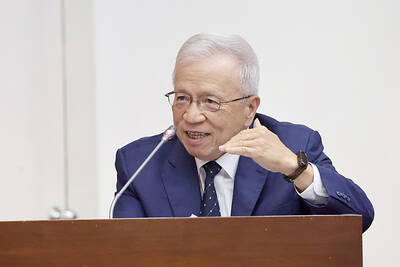Financial payments start-up Square Inc was on Friday at work on a real-world wallet for safely pocketing cryptocurrency.
Square founder and CEO Jack Dorsey, who is also the top executive at Twitter Inc, last month on Twitter asked for feedback on the notion.
“This community’s response to our thread about this project has been awesome — encouraging, generous, collaborative and inspiring,” Jesse Dorogusker, a member of Square’s hardware team, wrote on Twitter on Thursday.

Photo: Reuters
“We have decided to build a hardware wallet and service to make bitcoin custody more mainstream,” he said.
Dorsey endorsed Dorogusker’s post, tweeting: “We’re doing it #bitcoin.”
Hardware wallets can be used to store digital currency offline, synchronizing with applications for transactions on the Internet as needed.
Another option for cryptocurrency owners is to use “virtual” wallets, essentially trusting third parties to keep money safe and using passwords to access funds.
Dorsey on Twitter said that bitcoin is a currency for the masses, and that it is important to have ways for people to hold it that do not involve entrusting it to outside parties.
“The exchange you used to buy your bitcoin probably attends to your security with good intent, but circumstances may reveal ‘custody’ actually means ‘IOU,’” Dorsey wrote on Twitter last month, referring to a shorthand for “I owe you.”
“Deciding to take custody, and security, of your bitcoin is complicated,” he added.
Dorsey envisioned a bitcoin wallet that makes it easy for people to use some of it for shopping, for example through smartphones, while protecting the rest of the cryptocurrency.
“We can imagine apps that work without Square and maybe also without permission from Apple and Google,” he said, referring to the makers of the world’s two most widely used smartphone operating systems.
Square would set up accounts on Twitter and software developer community Web site GitHub dedicated to the bitcoin wallet project, Dorsey said.
In related news, a 101.38 carat diamond was sold at Sotheby’s for HK$95.1 million (US$12.3 million) in cryptocurrency, becoming the most expensive piece of jewelry sold through such type of payment, the auction house said.
The pear-shaped diamond, named “The Key 10138,” was on Friday sold to an unidentified private collector, Sotheby’s said in a statement.
The gem from Diacore Co was the second-largest pear-shaped diamond ever to be sold publicly, it said.
Prior to the sale, the international auction house said it would take bitcoin or ether as payment for the diamond, which fetched less than the estimate of as much as US$15 million in the single-lot offering in Hong Kong.
The auction was livestreamed and attracted no more than a dozen bids.
Earlier last week, Sotheby’s said it was the most expensive physical object ever publicly offered for purchase with cryptocurrency.
Auction houses are increasingly accepting cryptocurrencies for payment, with Phillips last month offering a piece from street artist Banksy for ether or bitcoin.
Christie’s in March accepted payment in ether for the record US$69.3 million sale of Beeple’s Everydays: the First 5,000 Days.
Additional reporting by Bloomberg

JITTERS: Nexperia has a 20 percent market share for chips powering simpler features such as window controls, and changing supply chains could take years European carmakers are looking into ways to scratch components made with parts from China, spooked by deepening geopolitical spats playing out through chipmaker Nexperia BV and Beijing’s export controls on rare earths. To protect operations from trade ructions, several automakers are pushing major suppliers to find permanent alternatives to Chinese semiconductors, people familiar with the matter said. The industry is considering broader changes to its supply chain to adapt to shifting geopolitics, Europe’s main suppliers lobby CLEPA head Matthias Zink said. “We had some indications already — questions like: ‘How can you supply me without this dependency on China?’” Zink, who also

At least US$50 million for the freedom of an Emirati sheikh: That is the king’s ransom paid two weeks ago to militants linked to al-Qaeda who are pushing to topple the Malian government and impose Islamic law. Alongside a crippling fuel blockade, the Group for the Support of Islam and Muslims (JNIM) has made kidnapping wealthy foreigners for a ransom a pillar of its strategy of “economic jihad.” Its goal: Oust the junta, which has struggled to contain Mali’s decade-long insurgency since taking power following back-to-back coups in 2020 and 2021, by scaring away investors and paralyzing the west African country’s economy.

BUST FEARS: While a KMT legislator asked if an AI bubble could affect Taiwan, the DGBAS minister said the sector appears on track to continue growing The local property market has cooled down moderately following a series of credit control measures designed to contain speculation, the central bank said yesterday, while remaining tight-lipped about potential rule relaxations. Lawmakers in a meeting of the legislature’s Finance Committee voiced concerns to central bank officials that the credit control measures have adversely affected the government’s tax income and small and medium-sized property developers, with limited positive effects. Housing prices have been climbing since 2016, even when the central bank imposed its first set of control measures in 2020, Chinese Nationalist Party (KMT) Legislator Lo Ting-wei (羅廷瑋) said. “Since the second half of

Taiwan Semiconductor Manufacturing Co (TSMC, 台積電) received about NT$147 billion (US$4.71 billion) in subsidies from the US, Japanese, German and Chinese governments over the past two years for its global expansion. Financial data compiled by the world’s largest contract chipmaker showed the company secured NT$4.77 billion in subsidies from the governments in the third quarter, bringing the total for the first three quarters of the year to about NT$71.9 billion. Along with the NT$75.16 billion in financial aid TSMC received last year, the chipmaker obtained NT$147 billion in subsidies in almost two years, the data showed. The subsidies received by its subsidiaries —